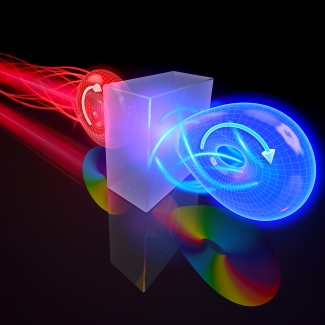For laser science, one major goal is to achieve full control over the spatial, temporal, and polarization properties of light, and to learn how to precisely manipulate these properties. One property of light, called the Orbital Angular Momentum (OAM), depends on the spatial distribution of the phase (or crests) of a doughnut-shaped light beam. More recently, a new variant of OAM was discovered—called the spatial-temporal OAM (i.e., ST-OAM)—with much more elusive properties, since the phase/crests of light evolve both temporally and spatially. A collaboration led by senior scientist Dr. Chen-Ting Liao, working with graduate student Guan Gui and JILA Fellows Margaret Murnane and Henry Kapteyn explored how such beams change after propagating through nonlinear crystals that can change their color. “Over the past few years, we have been studying pure spatial-OAM and its variations such as spin-orbit coupled OAM beams [2]and time-varying OAM beams (also called self-torqued beams).”Dr. Chen-Ting Liao stated. The team’s new results, published in Nature Photonics in 2021, uncovered the conservation laws underpinning how such an ST-OAM beam undergoes frequency doubling in a process known as Second Harmonic Generation (SHG).
Planes and Helicopters
SHG is considered one of the most fundamental non-linear processes, wherein two photons with the same energy interact with a nonlinear material and combine together. This generates a new photon that has double the energy of the original two photons. The team first used a pulse shaper to form ST-OAM light in the infrared region of the spectrum, and then focused it into a nonlinear crystal. Then they carefully characterized the output blue SHG light in space and time, to see how the spatial and temporal shape and phase/crests evolved over time.
Liao explained the differences in shapes between standard spatial and spatio-temporal OAM light sources. Spatial OAM moves like a plane propeller, where its angular momentum is parallel to the propagation of the light. In contrast, the ST-OAM moves like a helicopter rotor, where its angular momentum moves perpendicular to the direction of propagation of the light. Because of the differences between these two light sources, their charges, and energies of the sources,are different. In studying ST-OAM light using the SHG process, the team wanted to understand how the energy of the ST-OAM light flowed into the BBO (barium borate) crystals upon interaction with the crystals. To study this, Liao explained, the team needed to “experimentally extract...energy density flux of the spatial-temporal OAM beams in space and time to better understand what's going on in this process." From their data, the team found that the changes in the phases/crests of the blue ST-OAM light had increased compared with the red light, essentially doubling the topological charge, which is the quantity used to quantify the complex OAM shapes and phase patterns. Using the analogy, the helicopter rotors spin twice as fast as the plane propeller. Thus, they uncovered the conservation of topological charge of ST-OAM during frequency doubling, since the charge of each red photon was combined. Other possible applications for using ST-OAM waves from other nonlight sources include acoustic waves and matter waves.
The next steps for using ST-OAM waves seem pretty straight-forward. "We're trying to see if there are any potential applications for spatial-temporal OAM, because over the past three decades, the pure spatial-OAM has been used for optical tweezers, super-resolution imaging, and telecommunications," Liao said. "We can also use spatial-OAM for quantum entanglement and information, as well as defect inspection in the semiconductor industry, as we recently proposed [1]." While spatial-OAM is used for many processes, spatial-temporal OAM's applications are not so clear. With time, perhaps ST-OAM will have as many applications as spatial-OAM.
References:
[1] B. Wang, M. Tanksalvala, Z. Zhang, Y. Esashi, N. Jenkins, H. Kapteyn, M. Murnane, and C.-T. Liao*. “Coherent Fourier scatterometry using orbital angular momentum beams for defect detection.” Optics Express 29, 3342 (2021). DOI: https://doi.org/10.1364/OE.414584
[2] K. Dorney, L. Rego, N. Brooks, J. Román, C.-T. Liao, J. Ellis, D. Zusin, C. Gentry, Q. Nguyen, J. Shaw, A. Picón, L. Plaja, H. Kapteyn, M. Murnane, and C. Hernández-García, “Controlling the polarization, divergence and vortex charge of attosecond high-harmonic beams via simultaneous spin-orbit momentum conservation,” Nature Photonics, 13, 123 (2018).
Written by Kenna Castleberry, JILA Science Communicator




